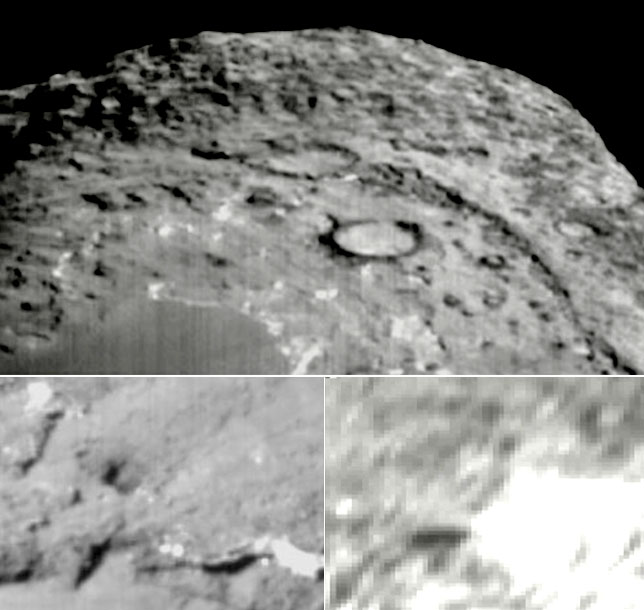|
by Wallace Thornhill Jan 13, 2006
from
Thunderbolts Website
Credit:
NASA/JPL--Caltech/UMD
We’ll hold off on a celebration for now,
but the pictures above appear to exhibit some of the “smoking guns”
that the electric theorists have predicted.
NASA’s observations came two days after impact, and the language used invites us to make further predictions. The patches will have nothing to do with “reflectivity”. They are better explained as the light of focused glow discharges, showing up as fuzzy whiteouts. They are the cometary equivalent to “St. Elmo’s fire” – coronal glow discharges sometimes observed dancing on high points in lightning storms on Earth.
Similar, but more powerful arcs on Jupiter’s moon
Io produced whiteouts that overloaded the Galileo probe camera and
surprised the investigators. These discharges on the comet’s surface
should show emission lines from ionized surface material and be
emitting ultraviolet light (something that arc welders know
well—it’s why they wear welder’s masks and protective clothing).
One reason for cautious optimism is the size of the
whiteouts in the last pictures taken before the projectile’s
camera’s shut down some 18 miles above the surface. (The very last
picture is seen in the lower right). Both ultraviolet light
emissions and “shocking” temperatures within the white spots would
be definitive evidence for the electrical nature of comets.
He said the plumes would be much hotter than NASA officials expected (in fact they produced the same kind of whiteouts now seen on Tempel 1). And he said that the supposed “lava lakes” on Io would be cold (they are simply the excavated terrain beneath the surface, exposed by the etching process.) Now it is becoming more clear every day that Thornhill’s successful predictions for Io, make what is happening on Tempel 1 all the more significant.
In the above pictures we see that the dominant
positions of the white spots are on the rims of craters and the
cliffs rising above valley floors. A particularly telling example of
this relationship is seen in the picture here
This tendency we see abundantly on Io, which makes an observation in a NASA release on Deep Impact all the more noteworthy:
On Io, the darkest surfaces are associated with recent arcing along
the edges of craters and cliffs, exposing the underlying rock.
Electrostatic fallback of ejecta covers the flat areas with lighter
material. The same thing seems to hold true for Tempel 1. The crater
rims and ridges are darkest. The circularity of the craters is also
characteristic of arc machining and is not to be expected from
low-velocity impacts in the outer solar system.
The lower right image is the last from the impactor camera. Thornhill predicted an electrical flash before impact. Yesterday’s TPOD reported the surprise expressed by NASA’s expert on high-velocity impacts, Peter Schultz, when two flashes were seen. The lack of images in the last few seconds would be explained simply if the impactor was hit by a “cometary lightning bolt” seconds before contact. The “whiteout” seen in the lower right quadrant indicates significant electrical discharging near the impact point.
Data from the communications team and the flyby spacecraft cameras
should decide the issue.
|

